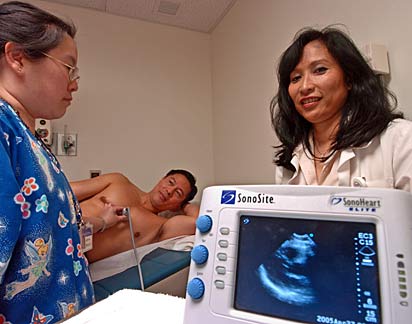
Val Heu, left, trained on the portable ultrasound device at the Queen Emma Clinic. Dr. Gerard Akaka served as the patient. Pearl Whittaker made sure everything went smoothly.
Healthier Hawaiians
A five-year program aims to reduce
heart failure by outfitting clinics with
portable ultrasound machines
Dr. Gerard Akaka smiled as he watched his heart pumping strongly on an ultrasound image.
Now when he gets short of breath at the gym he'll know it's not from a heart problem, he said.
"It looks good," confirmed Pearl Whittaker, senior sonographer at the Queen's Medical Center.
Akaka, medical director at the Queen Emma Clinic, volunteered for the test so Whittaker could train Val Heu, a medical assistant at the clinic, to do sonograms.
The clinic is one of five participating in a five-year program aimed at reducing heart failure and improving overall health in native Hawaiians and other Pacific Islanders.
The Queen's Medical Center and the University of Hawaii's John A. Burns School of Medicine are conducting the program under a $6 million National Institutes of Health grant.
"The overall goal is to reduce disparities in health for patients with heart failure," said Dr. Todd Seto, cardiologist and medical director for Queen's Center for Best Healthcare Practices.
"There's good evidence that even though we do a very good job of treating patients with heart failure, there are still some inequities," he said.
Compared to other ethnic groups in Hawaii, native Hawaiians have higher rates of hypertension, diabetes, chronic lung disease and heart disease -- all conditions associated with development of heart failure, he said.
"We're trying to find the causes of heart failure," Seto said. "It seems to many people that causes of heart failure among native Hawaiians and Pacific Islanders seem to be different than others."
A lot of treatments for people with heart failure are based on other populations, he pointed out. "Maybe we're providing care that has to be fine-tuned for native Hawaiians. We need more information."
Seto is working on the new program with Dr. Marjorie K. Mau, professor and chairwoman of the medical school's Department of Native Hawaiian Health.
The department was formed with a $5 million contribution in 2002 from the Queen's Health Systems to work with Queen's and other organizations on health disparity issues in native Hawaiians.
Mau said the partnership's first goal is trying to improve access to health care in the participating clinics: Queen Emma Clinic, Kalihi-Palama Community Health Center, Kokua Kalihi Valley Community Health Center, Waianae Coast Comprehensive Health Center and Waimanalo Health Center.
Two people are being trained at each site as community-based research assistants to perform simple heart ultrasounds to detect heart failure, Mau said. Each clinic will be equipped with a small hand-carried ultrasound device called SonoSite.
Chuck Braden, Waimanalo Community Center executive director, said the ability to have an ultrasound exam done at a community center "is awesome." It will keep patients from having to go to a hospital for testing, he said.
The portable system "is a major enhancement in care for our patients," he said.
Even Queen Emma Clinic doesn't have access to ultrasound technology, noted May Vawer, clinical research nurse and program manager for the grant. When patients have to make an appointment at the hospital's Echocardiograph Lab, they fall through the cracks, she said.
Mau said, "The study is about seeing if it's possible to train people and build capacity in the communities (for heart diagnosis) even when the research project is completed."
It will help doctors make decisions about whether to refer patients for a full cardiac work-up or just change their diet and lifestyle, she said. "If it does work out, it will be something perhaps other outlying clinics would be able to do in the future."
Akaka, who was at the Waianae Coast Comprehensive Health Center from 1995 to 2002, said the portable ultrasound unit and trained workers will enable the clinics to distinguish signs of heart disease from asthma and other conditions. Once the problem is diagnosed, it can be treated appropriately, he said.
Now, he said, doctors at the community centers must base their decisions on physical exams and "give it our best shot."
Whittaker said the program will reach into the communities and provide education as well as screening tools to help people recognize congestive heart failure and steps they can take to improve their health.
Cultural disparities will be examined to see how differences might pose barriers to treatment and care, she said. "We need to tailor education to the community we're dealing with."
Seto said the main question to answer with the small ultrasound system is how well the heart is pumping.
"It is a very simple, economical, safe, reliable way to look for heart failure."
A self-management education program also will be designed as part of the project that's particularly relevant to native Hawaiians, he said.
"A lot of concepts are for heart disease but this project is for heart failure," he added, explaining the program will look at how people manage food, fluid and salt intake, if they exercise and know the signs and symptoms of heart failure before getting too sick.
The researchers also will look at families with a lot of heart failure to see why it's occurring, he said. "We think it is inherited."
Detailed family histories will be done primarily through Queen Emma Clinic to look for causes of heart failure.
Research also will be done with Queen's to test effectiveness of educating patients about the care for heart failure, Seto said.
He said the program overall will provide more information and improve health outcomes. "It will really help the state and native Hawaiians."
[News] [Business] [Features] [Sports] [Editorial] [Do It Electric!]
[Classified Ads] [Search] [Subscribe] [Info] [Letter to Editor]
[Feedback]
